Mount Rainier
 From Nwe
From Nwe | Mount Rainier | |
|---|---|
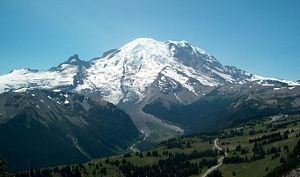 Mount Rainier as viewed from the Sourdough Ridge trail. |
|
| Elevation | 14,410 ft (4,392 m) |
| Location | Washington State, USA |
| Mountain range | Cascades |
| Prominence | 13,211 ft (4,026 m) Ranked 21st |
| Geographic coordinates | 46°51.1′N 121°45.4′W |
| Topographic map | USGS Mount Rainier West |
| Type | Stratovolcano |
| Geologic time scale | 500,000 years |
| Last eruption | 1854 |
| First ascent | 1870 by Hazard Stevens and P.B. Van Trump |
| Easiest Climbing route | rock/ice climb via Disappointment Cleaver |
Mount Rainier is a stratovolcano in Washington state, located 54 miles (87 km) southeast of the city of Seattle. In Pierce County, it is contained in the Cascade Volcanic Belt and is the highest peak in the Cascade Range. On clear days, it can be seen from as far away as Portland, Oregon, and Victoria, British Columbia.
At 14,411 feet, Mount Rainier towers 8,000 feet above surrounding Cascades peaks, such a behemoth that it creates its own weather. The mountain and the surrounding area comprise Mount Rainier National Park, and covers nearly 380 square miles. The mountain at its base covers 100 square miles. With 26 major glaciers, Mount Rainier is the most heavily glaciated peak in the lower 48 states at 35 square miles of snow and glaciers. It also has the lowest glacier in the continental United States at an elevation of just 1600 ft.
Mount Rainier ranks fifth in height of all mountains in the contiguous U.S., slightly lower than California's Mount Whitney (14,494 feet) and three Sawatch Range peaks in Colorado. It ranks second to Mount Shasta in total volume for a single peak, and second to Mount Baker in volume of glacial ice. However, there is no other peak that has the combination of high elevation, massive bulk, and extensive glaciation. Only forty miles separates Puget Sound from this glacier-clad summit.
No other peak nearby even remotely challenges its supremacy. Though located in a state with two mountain ranges, (the Cascades and the Olympic Range), Mount Rainier is known by locals simply and affectionately as, "The Mountain."
Geography
Mount Rainier is an active Cascade Range volcano encased in over 35 square miles of snow and glacial ice. The 14,410 foot mountain is surrounded by lush old growth forests, wildflower subalpine meadows and thundering waterfalls.
Summits
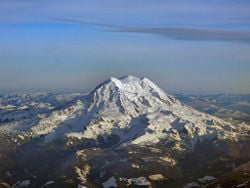
The broad top of Mount Rainier contains three named summits.
- Columbia Crest is the highest.
- Point Success is the second highest at 14,158 ft (4,315 m), at the southern edge of the summit plateau, atop the ridge known as Success Cleaver. It has a topographic prominence of about 138 ft (42 m), and as such is not considered a separate mountain.
- Liberty Cap is the lowest of the three summits at 14,112 ft (4,301 m). At the northwestern edge it overlooks Liberty Ridge, the Sunset Amphitheater, and the dramatic Willis Wall. Liberty Cap has a prominence of 492 ft (197 m), and so would qualify as a separate mountain under most strictly prominence-based rules.[1] However it is not usually considered a separate mountain, due to the massive size of Mount Rainier, relative to which a 492 foot drop is not very large.
High on the eastern flank of Mount Rainier is a peak known as Little Tahoma, a volcanic remnant of an earlier configuration of Mount Rainier. At 11,138 ft (3,395 m), it has a prominence of 858 ft (262 m), and is almost never climbed in direct conjunction with Columbia Crest, so it is usually considered a separate mountain.
Rivers' Sources
The Carbon River, Puyallup River, Nisqually River, and Cowlitz River all begin at the glaciers of Mount Rainier. The sources of the White River in Washington State are Winthrop, Emmons, and Fryingpan Glaciers. The White and Carbon Rivers join the Puyallup River, which discharges into Commencement Bay at Tacoma, Washington. The Nisqually empties into Puget Sound east of Lacey, Washington, and the Cowlitz joins the Columbia River between the towns of Kelso and Longview, Washington.
Vegetation
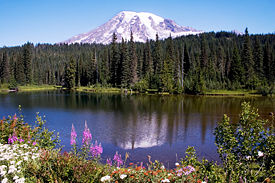
In general a difference of 1000 feet in altitude brings about changes in plant and animal life that are quite similar to the changes caused by a difference of 300 miles in latitude. There are four life zones found on Mount Rainier; the Humid Transition, the Canadian, the Hudsonian and the Arctic-alpine. [2]
- The Humid Transition Zone takes in the area of elevation up to approximately 3,000 feet. It is the most heavily forested zone. Plants and animals in this zone blend into the Canadian zone so there is not a clear delineation between species living in the two zones. The grand fir, western red cedar western hemlock, Pacific tree dogwood, and the Douglas fir are trees commonly found in this zone.
- The Canadian Zone covers the area from about 3,000 ft to up to 5,000 ft. In this zone, the trees are notably smaller and not as dense as in the Humid Transition Zone. The western hemlock and Douglas fir are its common members. Some other typical tree species found in the Canadian Zone are the amabilis fir, Alaskan cedar, noble fir, and western white pine.
- The Hudsonian Zone consists of sub-alpine meadows with alpine fir and Mountain Hemlock. Its range is from 5,000 to 6500 ft. There is snow in the area most of the year from about November 1 through July 4 with some snow still remaining until mid-summer.
- The Arctic-alpine Zone includes all of the area above the upper limit of tree growth. This zone is from about 6500 feet to the summit. Plants in this zone are found between 6500 and 7500 ft. There is about 80 square miles of this zone on Mount Rainier. Some of the common plants are the mountain buckwheat, pussy paws, moss campion, and willow grass. Some mosses grow around the rim of the crater because of warm gases escaping from fissures near the summit. The Arctic zone with its shallow soil and is many rocks is home to numerous species of insects and spiders. At Yakima Park near Frozen Lake and on Burroughs Trail one can find an exceptional Arctic-alpine growth, consisting of colorful Indian pink and Lyalls lupine growing out of the pumice type soil. [3]
Climate
A Pacific maritime climate characterized by rainy, mild winters and cool, dry summers controls northwest weather patterns. Mountain weather is very changeable. Wet, cold weather can occur anytime of the year. While late-July and August can be the driest, warmest time of the year, summer can also be wet and cool. [4]
Even though the northern section of the state of Maine and Mount Rainier are on the same latitudinal lines, Mount Rainier does not have the same frigid temperatures as Maine. The prevailing westerly winds, blowing in from the Pacific Ocean, bring more moderate temperatures to the mountain.
Longmire, located in the Humid Transition Zone, has an average temperature of 55 degrees F and a high of 105 Degrees F with a low of -9 degrees F. Paradise Park, in the Hudsonian Zone, has an average temperature of 47 degrees F. Its high is 92 degrees, with its lowest temperature being -20 F.
Common with other areas of like altitude west of the Cascade Range, it is characterized by heavy precipitation. Over 75 percent of the total annual precipitation falls from October through May. Based upon records of the U. S. Weather Bureau the average annual precipitation for Paradise Park (at 5,557 feet) is roughly 100 inches. This may be contrasted with the record for Longmire (at 2760 feet) where the average annual rate is about 78 inches.
Wildlife
Wildlife abounds on Mount Rainier. Commonly seen mammals are ground squirrels, chipmunks, chickarees, marmots, and pika. Ravens, Clark's nutcrackers, gray jays, and Steller's jays are birds common to the area. Deer are frequently seen, but black bear, elk, and mountain goats are more elusive. Mountain goats stay close to the high country cliffs.
Geology
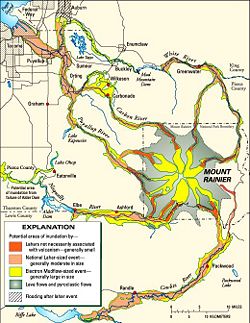
Geological history
Mount Rainier's earliest lavas are over 840,000 years old and are part of the Lily Formation (2.9 million to 840,000 years ago). The early lavas formed a "proto-Rainier," or ancestral cone, prior to the present-day cone which is over 500,000 years old. The volcano is highly eroded, with glaciers on its slopes, and appears to be made mostly of andesite.
Around 5,000 years ago, a large chunk of the volcano slid away, with the resulting debris avalanche producing the massive Osceola Mudflow. This massive avalanche of rock and ice took out the top 1,600 ft. (488 m) of Rainier, bringing its height down to around 14,400 ft. (4,389 m). Prior to this, it is believed to have stood at 16,000 feet. [5] About 530 to 550 years ago, the Electron Mudflow occurred, although this was not as large-scale as the Osceola Mudflow.
After the major collapse 5,000 years ago, subsequent eruptions of lava and tephra (air-fall material) built up the modern summit cone until as recently as 1,000 years ago. As many as 11 Holocene epoch tephra layers have been found.
The most recent recorded volcanic eruption was between 1820 and 1854, though many eyewitnesses had reported eruptive activity in 1858, 1870, 1879, 1882 and 1894 as well. Though there seems to be no imminent risk of eruption, geologists expect that the volcano will erupt again.
Glaciers
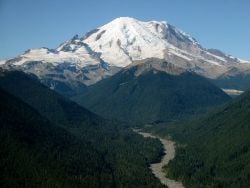
Glaciers are among the most conspicuous and dynamic geologic features on Mount Rainier. Glaciers deform and flow continuously, regulated in large part by climatic conditions. These changes typically take several years or more to become apparent and are therefore considered sensitive indicators of climate changes.
Mount Rainier has 26 recognized glaciers. Its largest glaciers are:
- Nisqually Glacier, which is one of the most accessible glaciers on Mount Rainier.
- Cowlitz-Ingraham Glacier, which is best seen from the upper slopes of the mountain.
- Emmons Glacier, which is on the east slope of the mountain and has a surface area of 4.3 square miles, the largest area of any glacier in the contiguous United States.
- Carbon Glacier has the greatest measured thickness (700 feet) and volume (0.2 cubic miles) of any glacier in the contiguous United States. The glacier terminus is at a relatively low elevation and is surrounded by mature forest and shrubbery.
Glaciers erode the volcanic cone and provide the source of stream flow for several rivers, including some that provide water for hydroelectric power and irrigation. Together with perennial snow patches, glaciers cover about 36 square miles of Mount Rainier's surface, about nine percent of the total park area, and have a volume of about one cubic mile. [6]
Lahars
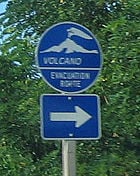
In the past, Mount Rainier has had not only large debris avalanches, but has also produced enormous lahars (volcanic mudflows) due to the large amount of glacial ice present. Its lahars have reached to Puget Sound, 150 miles away.
One of the greatest volcanic hazards is lahars, which are similar to pyroclastic flows but contain more water. Lahars formation comes from several sources:
- from debris avalanches that contain water from snow and ice which, when released, mixes with loose debris to form a lahar,
- from pyroclastic flows and surges which release water that mixes with debris,
- from pyroclastic flows which dilute themselves with river water as they travel downslope,
- from natural dam failure (such as a lava flow dam or crater lake), and
- from rainfall on loose material such as ash. Lahars that contain 20 to 60 percent sediment are usually very turbulent. [7]
A lahar flow is similar to that of wet concrete. Once they are flowing, they can reach speeds of 70 - 80 kilometers per hour and have depths up to 30 meters. Large lahars have occurred on Mount Rainier every 500 to 1000 years. The most recent large lahar poured into the Puyallup River Valley about 575 years ago. Geologists have every reason to expect that future lahars will continue their reccurring pattern.
According to geologists, due to the weakening of Rainier by hydrothermal activity combined with its heavily–iced top, the threat of lahars is real. Such a mudflow could destroy much of the heavily populated western Washington state. Reaching to Puget Sound, it could cause tsunamis there as well as in Lake Washington.
Monitoring systems
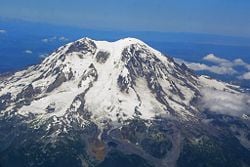
With Mount Rainier considered an active volcano, and the heavy population numbers surrounding it, there is vigilant monitoring performed by the United States Geological Survey (USGS) at the Cascade Volcano Observatory in nearby Vancouver, Washington. The University of Washington (Seattle) also measures, on a regular basis, any changes in the shape of the mountain.
An eruption that could produce a catastrophic lahar initiated by vigorous release of meltwater is expected to follow days, weeks, or even months of readily detected symptoms of volcanic unrest. Thus, it is likely that there would be opportunity for citizens and communities to prepare for an impending eruption. Inasmuch as lahars seek valley bottoms, people can quickly climb or drive to safety in many cases by simply evacuating the floor of a well-defined valley before the lahar arrives; they need go no farther than high ground adjacent to the valley.
A critical issue is to know when evacuation is necessary. Travel time for a large lahar from Mount Rainier may be an hour or less to the nearest city in the Puyallup valley, and possibly as little as 30 minutes may be available from detection of a large lahar to its arrival.
The U.S. Geological Survey is urging that an automated lahar-detection system be put into place. Except during volcanic unrest when intense around-the-clock monitoring by a team of volcanologists is underway, the time from initiation of a lahar to its arrival in a populated valley-floor area is insufficient for analysis of the data by scientists before notices are issued. Thus the system they are promoting must be designed to unfailingly detect a lahar with minimum opportunity for false alarms.
Human history
At the time of European contact, the river valleys and other areas near Mount Rainier were inhabited by many Pacific Northwest Native American tribes who hunted and gathered berries in the forests and mountain meadows. These tribes included the Nisqually, Cowlitz, Yakima, Puyallup and Muckleshoot.
Mount Rainier was first known by the Native Americans as Talol, Tahoma, or Tacoma, from the Puyallup word meaning "mother of waters."
Captain George Vancouver reached Puget Sound in 1792 and became the first European to see the mountain. He named it in honor of his friend, Rear Admiral Peter Rainier.
In 1833, Dr. William Fraser Tolmie explored the area looking for medicinal plants. He was followed by other explorers seeking challenge. In 1857 an army lieutenant, August Valentine Kautz attempted the climb with companions and a guide. By the eighth day, the guide was suffering from snow blindness and his companions were discouraged. Kautz continued alone, reaching the 14,000 feet level. He was approximately 400 feet shy of the summit.
Hazard Stevens and Philemon Van Trump hired a Yakima Indian named Sluiskin to be their guide assisting them to reach the summit of Mount Rainier. They reached their goal on August 17, 1870, after 10 and one half hours of climbing, leaving a brass nameplate and a canteen on the summit to document the first successful ascent recorded.
Stevens and Van Trump received a hero's welcome in the streets of Olympia, Washington after their successful summit climb. The publicity of their success brought others to challenge the summit. In 1890, Fay Fuller became the first woman to climb Mount Rainier. [8]
Naturalist John Muir from Scotland climbed Mount Rainier in 1888, and although he enjoyed the view, he conceded that it was best appreciated from below. Muir was one of many who advocated protecting the mountain. In 1893, the area was set aside as part of the Pacific Forest Reserve in order to protect its physical and economic resources, timber and watersheds.
Citing the need to also protect scenery and provide for public enjoyment, railroads and local businesses urged the creation of a national park in hopes of increased tourism. On March 2, 1899, President William McKinley established Mount Rainier National Park as America's fifth national park. Congress dedicated the new park "for the benefit and enjoyment of the people; and … for the preservation from injury or spoliation of all timber, mineral deposits, natural curiosities, or wonders within said park, and their retention in their natural condition."
Recreation
Mount Rainier is a part of Mount Rainier National Park, established in 1899. About 1.3 million people visit the park each year, with 10,000 people attempting to conquer the summit of Mount Rainier. Approximately 25 percent make it to the top.
The park was designated a National Historic Landmark in February 1997 as a showcase for the National Park Service Rustic style architecture of the 1920s and 1930s. As an Historic Landmark district, the park was administratively listed on the National Register of Historic Places.
The park contains outstanding examples of old growth forests and subalpine meadows. It is a natural setting of the Pacific Northwest region. Things to be done on a visit to Mount Rainier include:
- The Summit—Reaching the summit requires a vertical elevation gain of more than 9,000 feet over a distance of eight or more miles. This adventure involves climbing across rocky slopes and up steep snowfields to Camp Muir, where normally a night's sleep is recommended before an early morning assault on the peak itself. From Camp Muir, the route mounts the spires of Cathedral Rocks, crossing the upper crevasses of Ingraham Glacier, then climbs near-vertically up the summit snowfields to Columbia Crest, Mount Rainier's highest peak. Winter conditions generally exist from mid-September to mid-May, with winter storms being frequent and severe, with high winds, deep snow, and extremely poor visibility.
- The Road to Paradise - Perhaps the most accessed of Mount Rainier's treasures is the drive to Paradise Inn. Incredible vistas with views of Mount Saint Helens, Mount Hood, and Mount Adams line the drive. The arrival at Paradise provides incredible views. The stark white summit cone of Mount Rainier half fills the sky. Massive Nisqually Glacier chokes a wide cleft in the volcano's flank. Colorful wildflowers bend in the breeze, filling meadow after meadow with vivid, unexpected color.
- Wildflowers—The alpine and subalpine meadows of Paradise and Sunrise are filled with wild asters, daisies, orchids, cinquefoil, and heather. Along Skyline Trail you will find wildflower meadows filled with yellow glacier lilies, marsh marigolds, western anemones, and purple shooting stars.
- Grove of the Patriarchs—The Ohanapecosh district is a preserve of rushing waters and dense old-growth forest in the park's southeast corner. Some of the largest trees in the park, many of them more than 1,000 years old, are here. The Grove of the Patriarchs, on an island in the Ohanapecosh River, is reached by bridge along a trail. Here you will find a collection of huge Douglas firs and Western red cedars.
- Mowich Lake—The Carbon River area is a preserve of misty woodlands and deep-channeled rivers in the northwest corner of the park. Up the road from this temperate rain forest is Mowich Lake, which offers stunning views of the glaciered face of Mount Rainier and is a favorite with backcountry campers and paddlers.
- Campsites—There are nearly 600 campsites surrounding Mt. Rainier, located mostly within six major campground areas: Cougar Rock Campground, Ipsut Creek Campground, Mowich Lake Campground, Ohanapecosh Campground, Sunshine Point Campground, and White River Campground.
- Wonderland Trail—The Wonderland Trail loops around Mt. Rainier, crossing glacier-fed rivers and passing through varied terrain, including alpine and subalpine meadows, dense forest, and rocky barrens, for a distance of 93 miles. A full traverse of the trail takes a minimum of 10 days, including some strenuous climbs and descents.
- Winter Sports—Mount Rainier is one of the snowiest places on earth, with winter beginning usually in late October. Available activities include cross country skiing, snowboarding, snowplay including sliding, snowshoe walks, snowmobiling and camping.
Notes
- ↑ Peter Klist, Washington 100 Highest Peaks, The Northwest Peakbagger's Asylum. Retrieved May 17, 2016.
- ↑ Flora of Mt. Rainier National Park, Mount Rainier National Park Nature Notes Vol. XVI, March - June, 1938, Nos. 1 & 2. Retrieved May 17, 2016.
- ↑ Mt. Rainier Birds, National Park Service. Retrieved April 3, 2007.
- ↑ Mount Rainier, National Park Service. Retrieved April 3, 2007.
- ↑ Bette E. Filley, The Big Fact Book About Mount Rainier (Dunamis House, 1996, ISBN 978-1880405062).
- ↑ Glaciers on Mount Rainier, National Park Service. Retrieved May 17, 2016.
- ↑ C.M. Riley, Lahars, Michigan Technological University. Retrieved April 3, 2007.
- ↑ Craig Roman, Fay Fuller – First Woman to Summit Mount Rainier, Visit Rainier. Retrieved May 17, 2016.
References
ISBN links support NWE through referral fees
- Filley, Bette E. The Big Fact Book About Mount Rainier. Dunamis House, 1996. ISBN 978-1880405062
- Harris, Stephen L. Fire mountains of the West: the Cascade and Mono Lake volcanoes. Montana: Mountain Press Pub. Co., 2005. ISBN 087842511X
- Riley, C. M. Lahars, Michigan Technological University. Retrieved April 3, 2007.
- Sisson, Thomas W. History and Hazards of Mount Rainier, Washington. Washington: Cascades Volcano Obervatory, 1995. OCLC 48548643
- Mount Rainier, Washington, Peak Bagger. Retrieved April 3, 2007.
External links
All links retrieved October 25, 2018.
- Volcano Hazards Program: Mount Rainier, United States Gelogical Survey
- Mount Rainier, Summit Post
- Mount Rainier National Park, Terra Galleria
- Mt Rainier, Destination 360
- Mt. Rainier Photographs by Lawrence Denny Lindsley, Digital Collections
- Mount Rainier Photographs by Alvin H. Waite, Digital Collections
- Maps and aerial photos
- WikiSatellite view at WikiMapia
- Topographic map from TopoZone
- Surrounding area map from Google Maps
- Location in the United States from the Census Bureau
| Major Cascade Volcanoes |  |
|---|---|
| Mount Silverthrone | Mount Meager | Mount Cayley | Mount Garibaldi | Mount Baker | Glacier Peak | Mount Rainier | Mount St. Helens | Mount Adams | Mount Hood | Mount Jefferson | Three Sisters | Newberry Volcano | Mount Mazama | Mount McLoughlin | Medicine Lake Volcano | Mount Shasta | Lassen Peak |
| U.S. State Highest Points |  |
|---|---|
| Alabama - Alaska - Arizona - Arkansas - California - Colorado - Connecticut - Delaware - Florida - Georgia - Hawaii - Idaho - Illinois - Indiana - Iowa - Kansas - Kentucky - Louisiana - Maine - Maryland - Massachusetts - Michigan - Minnesota - Mississippi - Missouri - Montana - Nebraska - Nevada - New Hampshire - New Jersey - New Mexico - New York - North Carolina - North Dakota - Ohio - Oklahoma - Oregon - Pennsylvania - Rhode Island - South Carolina - South Dakota - Tennessee - Texas - Utah - Vermont - Virginia - Washington - West Virginia - Wisconsin - Wyoming |
Credits
New World Encyclopedia writers and editors rewrote and completed the Wikipedia article in accordance with New World Encyclopedia standards. This article abides by terms of the Creative Commons CC-by-sa 3.0 License (CC-by-sa), which may be used and disseminated with proper attribution. Credit is due under the terms of this license that can reference both the New World Encyclopedia contributors and the selfless volunteer contributors of the Wikimedia Foundation. To cite this article click here for a list of acceptable citing formats.The history of earlier contributions by wikipedians is accessible to researchers here:
- Mount Rainier history
The history of this article since it was imported to New World Encyclopedia:
- History of "Mount Rainier"
Note: Some restrictions may apply to use of individual images which are separately licensed.
↧ Download as ZWI file | Last modified: 02/04/2023 03:52:34 | 28 views
☰ Source: https://www.newworldencyclopedia.org/entry/Mount_Rainier | License: CC BY-SA 3.0
 ZWI signed:
ZWI signed: KSF
KSF